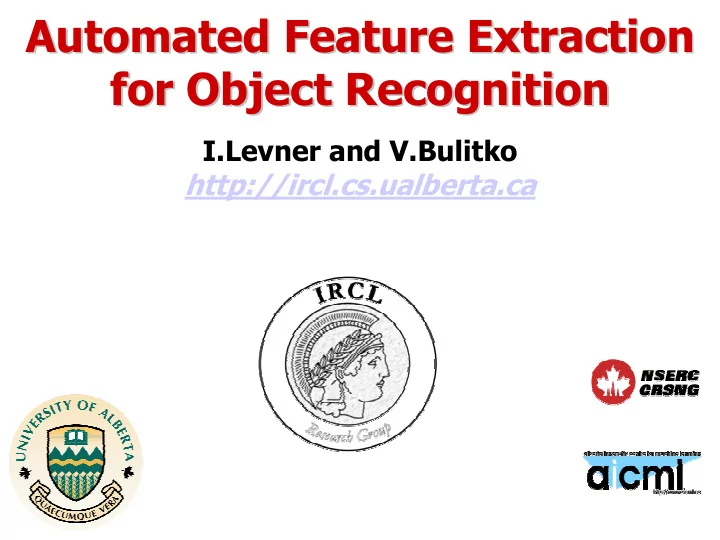

Automated Feature Extraction Automated Feature Extraction for Object Recognition for Object Recognition I.Levner and V.Bulitko http://ircl.cs.ualberta.ca
Outline Outline • Motivation • System Overview • Feature Extraction Problem • Conclusion
M OTIVATION M OTIVATION Large volumes of image data • Military Volcanoes on Venus MRI image of a brain tumor • Industrial • Scientific Aerial Plantation Image • Medical
Current Approach Current Approach Domain Experts Analyze and Interpret Images • costly • error-prone • tedious
Automated Image Interpretation Single sequence Multi-sequence Input Input Output Static Sequence of Operators On-line Control Policy applied regardless of input adaptively selects a sequence image characteristics of operators
States, Actions and Processing Levels within ADORE Data Tokens = MDP States Image Processing Routines = MDP Actions
User- -provided Training Datum provided Training Datum User y r a e r g b a i m L I g n i s s e c o r P Initial Desired Image Label Full breadth Reward limited depth computation expansion Dynamic Programming (state,action,Q) (state,action,Q) Possible Labels
Machine Learning Feature Feature Function extraction (f(state),action,Q) extrapolation extraction (f(state),action,Q) (state,action,Q) (state,action,Q) essor are needed to see this picture Sampled Abstracted Abstracted Q-function Sampled Approximated Q-function Q-function
Abstracted Approximated Q-function essor are needed to see this picture Novel MR ADORE Input Output Image Label Control Policy Control Policy Off-the-shelf IPL Library IPL
Problem Automated Image Interpretation still requires manual feature selection manual feature selection by domain and vision experts •[Draper00] •[Levner03a] Solution • Use dimensionality reduction techniques to compress raw data and in the process extract relevant features extract relevant features
Problem Automated Image Interpretation still requires manual feature selection manual feature selection by domain and vision experts •[Draper00] •[Levner03a] Solution • Use dimensionality reduction techniques to compress raw data and in the process extract relevant features extract relevant features
Preliminary Experiments Compare performance of on-line policies using : No features . • Classical approach using best single sequence regardless of data characteristics. ( Static) PCA coefficients as features • together with 1-NN (various metrics) Raw Pixels as features • together with 1-NN (various metrics) Hand-Crafted features • HSV color histograms as features showed best performance when used by artificial neural networks [Levner03a].
Results Hand- -Crafted methods still Crafted methods still Hand outperform automated approaches outperform automated approaches
F UTURE R ESEARCH • Focus of Attention Processing - smaller input image size - reduce image variance • Non-linear manifold learning methods -kPCA, pPCA -MDS, LLE, Isomap - require knn + distance metric ? • Incremental PCA methods - allow larger sample size • Library of Feature Extractors
References B. Draper, et al., ADORE: Adaptive Object Recognition . Videre , 1(4):86–99, 2000. I. Levner, et al., Towards automated creation of image interpretation systems . In Proceedings of Australian Joint Conference on Artificial Intelligence , 2003. I. Levner , et al., Automated Feature Extraction for Object Recognition , In Proceedings of the Image and Vision Computing New Zealand conference, 2003.
Recommend
More recommend